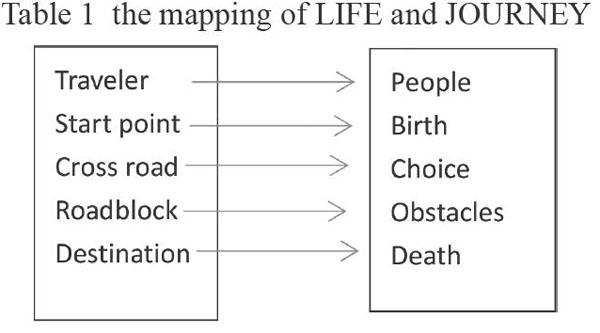The Relationship between Metaphor and Metonymy


【Abstract】Metaphor and metonymy has been widely discussed in cognitive linguistics. However, there are also some problems concerning their relationship. Some linguists deem that metaphor is more basic than metonymy. While others claim metonymy is the foundation for metaphor, In this paper, so as to solve these uncertainties about their relationship and to present an overview of metaphor and metonymy, the paper will analyze the characteristic of metaphor and metonymy and then delineate their differences, hence reaching the relationship of metaphor and metonymy.
【Key words】metaphor; metonymy; continuum
1. Introduction
People are familiar with the concepts of metaphor and metonymy. However, about their relationships, there are some uncertainties. Conceptual metaphor is firstly proposed by Lakoff and Johnson in Metaphors We Live by. They claim that metaphor is not just a device of rhetoric, but a way of thinking. So the research of metaphor is wider than that of metonymy. In other words, metonymy has somewhat ignored by researchers. Later, linguists began to study metonymy. Then some linguists propose that metonymy are more basic than metaphor; metonymy is the foundation for metaphor. Their evidence is as follows. Joseph Grady (1997) proposes that primary metaphor are motivated by experiential correlation; Radden (2003) has pointed out that correlation is fundamentally metonymic in nature. So the motivation of metaphor is metonymic in nature. That is, these linguists claim that metaphor has its root in metonymy. On the contrary, some linguists have affirmed that there is not a clear boundary between metaphor and metonymy; some expression can be interpreted in both aspects, which is depended on the context of situation.
From the analysis of the above paragraph, it can be gained that linguists are in disagreement about the relationship between metaphor and metonymy. In this paper, the working hypothesis is that metaphor and metonymy are in continuum relationship. That is, there is not a clear cut between them; they are related with each other and metonymy is more basic than metaphor. In the following section. The characteristic and differences between them will be analyzed. Then the continuum relationship will be tested from some examples.
2. Characteristic
2.1 Characteristics of Metaphor
For over 2000 years, metaphors are studied within the discipline known as rhetoric. (Evans,V. & Green.,M. 2006). That is, metaphor is regarded as tropes. However, in Metaphor We Live by, Lakoff and Johnson delineates metaphor from a different perspective: they reckon conceptual metaphor is a way of thinking, which means that our thought are metaphorical, from where the research about metaphor has been growing vigorously.
2.1.1 Descriptive
The function of metaphor is descriptive. To put it another way, we utilize metaphor to describe something that we are not familiar with. For example, people can not understand the nature of MARRIAGE. Then we can utilize the metaphor MARRIAGE IS A JOURNEY to help people to understand. The traveler is in correspondence with the couple. The road of journey is equivalent to the process of matrimony. The uneven part of the journey, such as the rocks in the road, symbolizes the obstacles in marriage life. For example, we can say that MY MARRIAGE IS ON THE ROCK.
From the above analysis, it is safe to say that the function of metaphor is to describe something that is abstract.
2.1.2 Unidirectional
Metaphor is the mapping between source domain and target domain.. Unidirectionality means that metaphors can only map structure from the source domain to the target domain. For example, LIFE IS A JOURNRY. In this metaphor, we conceptualize LIFE in terms of JOURNEY. That is , in this metaphor, in order to understand the abstract notion of LOVE, by using a simple and structured notion: JOURNEY, the items in the concrete source domain JOURNEY can be mapped to the abstract target domain LIFE. However; it cannot be reversed, in other words, from LIFE to JOURNEY, which is wrong.
2.1.3 Motivation
2.1.3.1 Embodiment with the outside world
Embodiment philosophy, as the theoretical cornerstone of cognitive linguistics, is very effective in explaining cognitive problems. People interact with the world, during which people gain a variety of experiences. Metaphors are grounded in the everyday interaction with the world. Only by interacting with the outside world, can we gain experiences. From these experiences, what can be gained the concrete images for the source domain.
2.1.3.2 Resemblance
As Kovecses (2002:20) puts it, “target domains are abstract, diffuse and lack clear delineation; as a result they ‘cry out for metaphorical conceptualization.” which means, people need the concrete source to understand the abstract notion. However, the relationship between them are not built at will. It is based on the resemblances between them. Take the following example:
LIFE IS A JOURNEY
Table 1 the mapping of LIFE and JOURNEY
From the above table, it can be found that LIFE and JOURNEY has the similar structure. Baaed on this resemblance, we have the metaphor LIFE IS A JOURNEY. That is, the source domain and the target domain are in somewhat related. We can not have the metaphor LIFE IS A DOG, or LIFE IS A RIVER, for they have no resemblance. So the motivation for metaphor includes embodiment with the outside world and the resemblance of these two domains.
There are other characteristic of metaphor, such as, invariance principle, the hiding and highlighting. While these parts are easy to understand, so the paper does not pay much attention to them.
2.2 Characteristic of metonymy
2.2.1 Referential
The function of metonymy is referential. Just as Vyvyan Evans & Melanie Green put it (2006:311), ‘linguistic metonymy is referential in nature: in relates to the use of expression to “pinpoint” entities in order to talk about them. For example, WE ARE SHORT OF HAND NOW. We use HAND to refer to people. That is, part of the person can activate the whole person, so metonymy is referential in nature.
2.2.2 Motivation
Metonymy is motivated by casual or physical associations, which is called contiguity. That is, the motivation for metonymy depends on the context of situation. For example, if a man goes to the restaurant and orders a hamburger, then he waits his hamburger to be delivered. A waiter may say this sentence to urge his colleague to be quick: “THE HAMBURGER IS WAITING HIS FOOD. Please hurry up!” In this metonymy, the waiter uses HAMBURGER to refer to THE MAN who just ordered one. If THE MAN ordered a sandwich just now, maybe the waiter will say: THE SANDWISH IS WAITING HIS FOOD.
From the above analysis, First, we can not deny that the production of metonymy are somewhat related with human experiences with the world. Second, the production of metonymy might be casual, which is totally different from metaphor.
2.2.3 domain matrix
This term is very important in the field of metonymy. In metaphor, it has two domains, however, in metonymy, it has only one domain. In the understanding of domain matrix, we should alert that a concept has domain matrix. Sometimes, we just highlight one domain of this concepts domain matrix. For example. SHAKESPEARE IS HARD TO READ. In this metonymy, we apply SHAKESPEARE to stand for the book written by him. That is, in the domain matrix of Shakespeare, we can talk about everything related to him, such as his habits, actions, his life and so on. However, in this metonymy, we just talk about his book. So we just highlight one domain of the Shakespearean domain matrix.
3. Similarities and Differences between metaphor and metonymy
3.1 Similarities between metaphor and metonymy
First, the motivation of them involves the experiences with the world; both of them have a experiential basis, which can be explained from the perspective of embodiment philosophy. Second, our thoughts are metaphorical and metonymic. We think in a metaphorical and metonymic way. Metonymy lay foundation for metaphor.
3.2 Differences between metaphor and metonymy
From the analysis, we can know there are many differences between them. About the differences, it can be gained from table 2
4. The relationship between metaphor and metonymy
Some linguists have put forward the relationship of these two. For example, Goossens (1990) presents a way in which metaphor and metonymy interact with each other, which includes metaphor from metonymy and metaphor within metonymy. Other linguists, such as Barcelona(2003) and Taylor(2003), they deem that metonymy is an operation that is more fundamental in the comparison with metaphor. So metonymy is the basis for metaphor. In my part, I claim that the relationship between them is a continuum. One side of the continuum is metonymy, the other side of the continuum is metaphor. The intermediate zone is the transition from metonymy to metaphor.
In my opinion, I claim that metonymy is more basic than metaphor. For example, we utilize “Tom” to refer to the boy, that is, tha name of the boy is metonymic in nature. Take another example, in Chinese, we can say “我打车回家”(I go home by taxi.). In this sentence. The verb “打” refer to the whole process of taking a taxi, such as, hailing a taxi, open the door of the taxi, closing the door of the taxi,telling the taxi where you go and so on. That is , “打”can generalize the whole process of taking a taxi. In conclusion, our life is filled with metonymy.
5. Conclusion
From the above analysis, the obscure theory of metaphor and metonymy might be more conspicuous. Metaphor and metonymy are closely related, they are both humans way of thinking. And metonymy is more basic than metaphor. So we should not ignore metonymy anymore.
References:
[1]Grady,J.‘Theories are building revisited,Cognitive Linguistics.2001.
[2]Radden,G.‘How metonymic are metaphors?,in A.Barcelona(ed.),Metaphor and Metonymy at the Crossroads.Berlin:Mounton de Gruyter.2003:93-108.
[3]Evans.V.& Green.M.Cognitive Linguistics An Introduction.[M].Edinburgh University Press.2006:293,311.
[4]Kovecses,Z.Metaphor:A Practical Introduction[M].Oxford:Oxford University Press.2002:20.
[5]Goossens,L.‘Metaptonymy:the interaction metaphor and metonymy in expression for linguistic action,Cognitive Linguistics,1990;1,3,323-40.
[6]Barcelona,A.Metaphor and Metonymy at the Crossroad:A Cognitive Perspective.[M].Berlin:Mounton de Gruyter.2003.
作者简介:张苗苗(1992-),河北衡水人,硕士研究生,主要研究方向为认知语言学、功能语言学。

